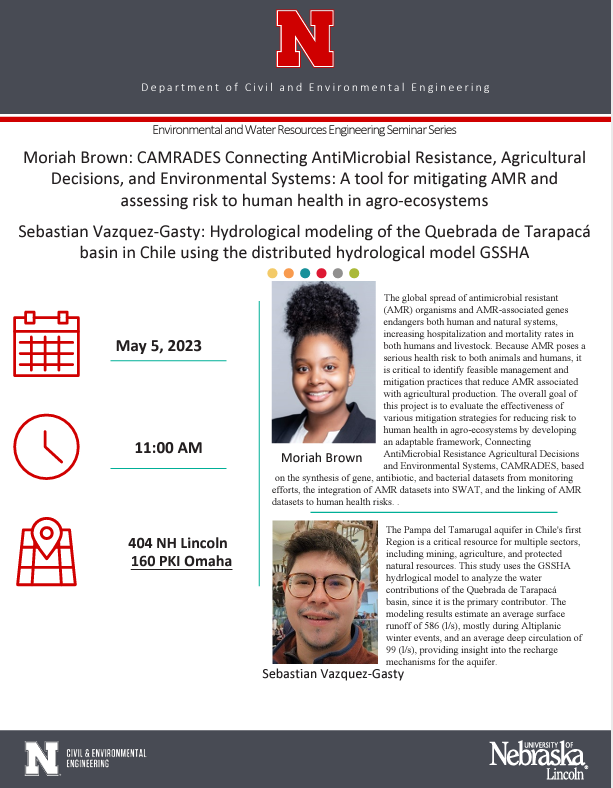
May 5, 2023
11:00 AM
404 NH Lincoln
160 PKI Omaha
Moriah Brown: CAMRADES Connecting AntiMicrobial Resistance, Agricultural Decisions, and Environmental Systems: A tool for mitigating AMR and assessing risk to human health in agro-ecosystems
The global spread of antimicrobial resistant (AMR) organisms and AMR-associated genes endangers both human and natural systems, increasing hospitalization and mortality rates in both humans and livestock. Because AMR poses a serious health risk to both animals and humans, it is critical to identify feasible management and mitigation practices that reduce AMR associated with agricultural production. The overall goal of this project is to evaluate the effectiveness of various mitigation strategies for reducing risk to human health in agro-ecosystems by developing an adaptable framework, Connecting AntiMicrobial Resistance Agricultural Decisions and Environmental Systems, CAMRADES, based The Pampa del Tamarugal aquifer in Chile's first Region is a critical resource for multiple sectors, including mining, agriculture, and protected natural resources. This study uses the GSSHA hydrlogical model to analyze the water contributions of the Quebrada de Tarapacá basin, since it is the primary contributor. The modeling results estimate an average surface runoff of 586 (l/s), mostly during Altiplanic winter events, and an average deep circulation of 99 (l/s), providing insight into the recharge mechanisms for the aquifer. on the synthesis of gene, antibiotic, and bacterial datasets from monitoring efforts, the integration of AMR datasets into SWAT, and the linking of AMR datasets to human health risks.
Sebastian Vazquez-Gasty: Hydrological modeling of the Quebrada de Tarapacá basin in Chile using the distributed hydrological model GSSHA
The Pampa del Tamarugal aquifer in Chile's first Region is a critical resource for multiple sectors, including mining, agriculture, and protected natural resources. This study uses the GSSHA hydrlogical model to analyze the water contributions of the Quebrada de Tarapacá basin, since it is the primary contributor. The modeling results estimate an average surface runoff of 586 (l/s), mostly during Altiplanic winter events, and an average deep circulation of 99 (l/s), providing insight into the recharge mechanisms for the aquifer.